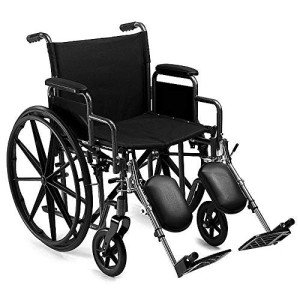
Having the proper seat width is necessary to wheelchair users who invest longer periods in their chairs. Too narrow a seat will cause pressure on the hips and thighs which might lead to sores or pressure points. Having too large a seat can also make it tough for the user to reach the hand rims to propel themselves or maneuver in little spaces.
To measure the correct seat width an individual would rest on a chair normally and have their measurement taken across their lap at the best point which is generally their hips. A wheelchair determining tape can be utilized to determine this, but a backyard stick is preferred as it avoids individuals from wrapping the tape around their hips which would offer an inaccurate result.
The basic wheelchair seat width is 16" (narrow grownup), 18" (basic adult), and 20" (wide adult). For bariatric clients, a 24" seat is readily available. This heavy-duty additional wide bariatric wheelchair from Medline features swing-away footrests, a carbon steel frame with rust- and chip-resistant chrome plating, and easy-to-clean vinyl upholstery. It has a weight capacity of 500 pounds.
Seat Depth
Generally, the seat depth of a bariatric wheelchair was included 2" to the measurement taken at the user's best point (generally their hips). This was indicated to accommodate additional layers of clothing that might be worn during cold weather. However, this practice is ending up being less common as wheelchair users have the ability to spend more time inside and are not wearing long coats. bariatric wheelchairs uk makes the seat depth of a chair lesser when selecting a bariatric wheelchair. However, lightweight bariatric wheelchair is still essential to pick a choice that provides sufficient assistance for bigger users.
The Medline folding extra broad bariatric manual wheelchair features a comfortable 24" seat width and a durable slide tube silver vein frame. It also has an adjustable axle and tool-free raising legrests.
Seat Height
When it pertains to figuring out the proper wheelchair seat width you need to always measure from the user's widest point which is usually their hips. You will likewise need to consider whether the user is going to be wearing a winter coat as this may add 2" to the width required.
When a wheelchair remains in use it must only be operated on level surfaces with the wheel locks fully engaged. This is to prevent the chair from having the ability to move slopes that are 10 degrees or greater. It is likewise crucial to keep in mind that any activity that may shift the center of gravity in the chair ought to be made with care. This includes grabbing products that need the individual to lean out of their seat or trying to stand from it.
Whenever you have the chair in usage it is advised that you regularly inspect it for damage and oil any areas that are considered required. For example, the casters need to be lubricated by eliminating the caster fork and using a multi-purpose grease to apply to the caster stem bearings. Similarly, the foot plates can be changed by loosening the bolt and then moving them to the desired position. This enables the feet to sit comfortably on the footplate and prevents any pressure points from forming. This can be really uncomfortable for the user and if left ignored, can lead to pressure sores.
Weight Capacity
Bariatric wheelchairs are developed to support more weight than basic wheelchairs. This makes them sturdier and much better equipped to handle falls. They are likewise normally larger and larger, making them less maneuverable in tight areas than standard wheelchairs. They require vehicles with unique ramps and lifts to load them, in addition to motorists who know how to best transport them from one area to the next.
When choosing a wheelchair, consider its weight capacity as it will be the main determining consider whether it will accommodate your traveler's needs. The weight capacity of the chair is typically noted as a fixed load, implying that it suggests the quantity of weight the chair can comfortably hold while standing still. Nevertheless, some makers likewise list an active load that is based on a drop test and can imitate the impact of someone sitting down in the chair. This might be a more reliable measurement of the weight limit, depending upon your needs.
If you plan to carry out activities that move your center of mass in the seat (such as reaching for objects), make sure to have front casters pointed in a forward instructions and wheel locks engaged so the chair will not tip over. Likewise, examine that casters are lubed routinely to avoid extreme wear and abrasions. The lubrication treatment involves removing the fork, separating the caster from the wheel, and greasing the caster stem bearings with premium multi-purpose grease.
